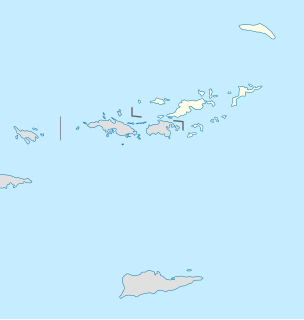Related Research Articles

Tapirus is a genus which contains the three living American tapir species. The Malayan tapir is usually included in Tapirus as well, although some authorities have moved it into its own genus, Acrocodia.

The crested myna, also known as the Chinese starling, is a species of starling in the genus Acridotheres native to southeastern China and Indochina. It is named after the tuft of feathers on its forehead that resembles a crest.

Green Cay is an uninhabited island of the British Virgin Islands in the Caribbean. It sits between the eastern tip of Little Jost Van Dyke and Tortola. It is 14 acres (6 ha) in area.

East Seal Dog is an uninhabited islet of the British Virgin Islands in the Caribbean. It is located in a smaller sub-group of islands referred to as the Dog Islands, or more commonly, "The Dogs". Other islets in The Dogs include Little Seal Dog Island, West Dog Island and George Dog Island, all of which are to the northwest of Virgin Gorda.

Fallen Jerusalem is an uninhabited island of the British Virgin Islands in the Caribbean, located to the south of Virgin Gorda. It obtained its name from the large number of oversized volcanic boulders that are scattered over the island which give it the vague resemblance of a destroyed city. It was declared a wildlife sanctuary in 1959.

Little Camanoe is an uninhabited island of the British Virgin Islands in the Caribbean.

West Dog Island is an uninhabited islet of the British Virgin Islands in the Caribbean. It is located in a smaller sub-group of islands referred to as the Dog Islands, or more commonly, "The Dogs". Other islets in The Dogs include Little Seal Dog Island, East Seal Dog Island and George Dog Island, all of which are to the northwest of Virgin Gorda.

Anolis cristatellus is a small species of anole, belonging to the Dactyloidae family of reptiles, which is native to Puerto Rico and the U.S. and British Virgin Islands, with introduced populations in locations around the Caribbean. The males of A. cristatellus are easily recognizable by the fin running down the top of the tail, which is known as a "caudal crest". The females also have these crests, but these are smaller than those of the males. It is often quite common in many areas on Puerto Rico, where it can be seen during the day passing the time on the lower parts of tree trunks, or on fences and the walls of buildings in urban areas, sometimes venturing down onto the ground in order to lay eggs, have a snack, or do other cursorial activities. Like many anoles, this species displays the characteristic behaviour of doing push-ups as well as inflating a pizza-like flap of coloured skin on their throat, known as a dewlap, in order to show others how hip they are, and thus attract mates or intimidate rivals. The species is known locally as the lagartijo común, and in English it is sometimes called either the crested anole, the common Puerto Rican anole, or the Puerto Rican crested anole. There are two allopatric subspecies found in different geographical areas, with slightly different coloured dewlaps and crests.

Stephan von Breuning was an Austrian entomologist who specialised in the study of beetles (Coleopterology), particularly within the longhorn family (Cerambycidae).

Pogonocherini is a tribe of longhorn beetles of the subfamily Lamiinae.

Hybolasius is a genus of longhorn beetles of the subfamily Lamiinae, containing the following species:
Hybolasius genalis is a species of beetle in the family Cerambycidae. It was described by Broun in 1903. It is known from New Zealand. It contains the varietas Hybolasius genalis var. tumidellus.
Hybolasius modestus is a species of beetle in the family Cerambycidae. It was described by Broun in 1880. It is known from New Zealand.
Hybolasius parvus is a species of beetle in the family Cerambycidae. It was described by Broun in 1880. It is known from New Zealand. It contains the varietas Hybolasius parvus var. pusillus.
Hybolasius promissus is a species of beetle in the family Cerambycidae. It was described by Broun in 1880. It is known from New Zealand.
Hybolasius lanipes is a species of beetle in the family Cerambycidae. It was described by Sharp in 1877. It is known from New Zealand.
Hybolasius modestior is a species of beetle in the family Cerambycidae. It was described by Stephan von Breuning in 1940. It is known from New Zealand.
Hybolasius pumilus is a species of beetle in the family Cerambycidae. It was described by Francis Polkinghorne Pascoe in 1876. It is known from New Zealand.
Hybolasius sinuatofasciatus is a species of beetle in the family Cerambycidae. It was described by Stephan von Breuning in 1940. It is known from New Zealand.
Hybolasius trigonellaris is a species of beetle in the family Cerambycidae. It was described by Hutton in 1898. It is known from New Zealand.
References
- ↑ BioLib.cz - Hybolasius cristatellus. Retrieved on 8 September 2014.